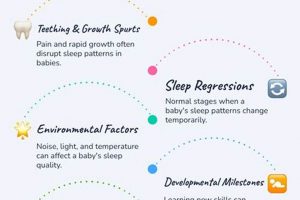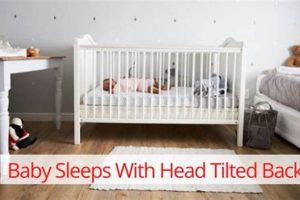The question of whether infants should be allowed to rest for extended periods within an inclined baby seat is a subject of considerable discussion. These seats, often designed to gently bounce or vibrate, are intended for short periods of supervised activity. The elevated angle they provide can seem comforting to some infants, potentially leading to drowsiness.
Using these devices for prolonged, unsupervised rest raises potential safety concerns. Historically, the recommendation was always to place infants on their backs on a firm, flat surface for sleep to minimize the risk of suffocation and Sudden Infant Death Syndrome (SIDS). Deviating from this established safe sleep practice could increase the probability of respiratory distress or positional asphyxia.
This exploration will delve into the specific risks associated with extended use of inclined baby seats for infant sleep, review expert recommendations on safe sleep practices, and outline alternative methods for comforting and settling infants to sleep. Understanding these factors is crucial for promoting infant safety and well-being.
Guidance Regarding Inclined Infant Seats and Sleep
The following points address the concerns surrounding the use of inclined infant seats for sleep, offering insights into safer alternatives and best practices.
Tip 1: Adhere to Safe Sleep Guidelines: Prioritize placing infants on their backs on a firm, flat surface, such as a crib mattress, for all sleep periods. This position significantly reduces the risk of SIDS.
Tip 2: Limit Supervised Time in Inclined Seats: These seats are designed for short, supervised periods of activity. Prolonged use, even under supervision, is not recommended.
Tip 3: Never Leave an Infant Unattended: Constant supervision is paramount when an infant is placed in an inclined seat. Leaving an infant unsupervised in such a device elevates the risk of positional asphyxia or other hazards.
Tip 4: Discontinue Use Once Rolling Over: Once an infant demonstrates the ability to roll over, cease using inclined seats altogether. This milestone increases the risk of the infant rolling into an unsafe position within the seat.
Tip 5: Consult with a Pediatrician: Discuss any concerns about infant sleep patterns or settling techniques with a qualified pediatrician. Professional guidance can provide tailored solutions for individual needs.
Tip 6: Explore Alternative Soothing Methods: Investigate alternative calming techniques, such as swaddling (when appropriate and safely executed), gentle rocking in a parent’s arms, or white noise, to encourage sleep.
Adhering to safe sleep practices and understanding the limitations of inclined infant seats is essential for promoting infant well-being. Prioritizing a safe sleep environment and seeking professional advice can mitigate potential risks and foster healthy sleep habits.
The following sections will further explore alternative sleep aids and strategies that promote infant comfort and safety.
1. Suffocation Hazard
The potential for suffocation represents a significant concern when considering infant sleep within an inclined bouncer seat. This hazard arises from a combination of factors inherent in the design and typical usage of such devices.
- Airway Obstruction due to Positioning
The semi-reclined position in a bouncer seat can cause an infant’s head to slump forward, potentially obstructing the airway. This is particularly dangerous for newborns who lack the neck strength to correct their position. Compromised airflow can rapidly lead to oxygen deprivation and suffocation.
- Soft Bedding and Loose Objects
While some bouncer seats include padding or soft fabrics for comfort, these materials, along with any blankets or toys placed nearby, can pose a suffocation risk. An infant could roll into or become entangled in these items, obstructing their breathing.
- Lack of Muscle Control
Infants, especially newborns, have limited muscle control and coordination. This can hinder their ability to reposition themselves if their airway becomes compromised, making them especially vulnerable to suffocation hazards within a bouncer seat.
- Inadequate Supervision
Even with attentive supervision, suffocation can occur rapidly. However, the risk is significantly elevated when an infant is left unsupervised in a bouncer seat, especially during sleep. The caregiver may not be present to intervene if the infant’s airway becomes obstructed.
These factors collectively highlight the heightened risk of suffocation associated with allowing infants to sleep in bouncer seats. Adhering to safe sleep guidelines, which emphasize a firm, flat sleep surface free of soft bedding, is crucial in mitigating this potentially fatal hazard. The inherent design and potential for misuse of bouncer seats render them unsuitable for prolonged infant sleep.
2. Positional Asphyxia
Positional asphyxia is a critical concern related to the use of inclined bouncer seats for infant sleep. This condition arises when an infant’s body position restricts their ability to breathe adequately. In bouncer seats, the semi-reclined position can cause the infant’s head to slump forward, compressing the trachea and limiting airflow. This is especially problematic for newborns and young infants whose neck muscles are not yet strong enough to maintain proper head control.
The inclined design of the bouncer seat, combined with the infant’s limited ability to reposition themselves, creates an environment conducive to positional asphyxia. For instance, if an infant’s chin rests on their chest for an extended period, the restricted airflow can lead to a decrease in oxygen levels, potentially causing brain damage or death. Unlike a flat, firm surface, the bouncer seat does not allow the infant to instinctively adjust their position to open their airway if breathing becomes difficult. This makes positional asphyxia a significant hazard that demands careful consideration.
In summary, positional asphyxia represents a direct threat associated with infant sleep in inclined bouncer seats. The risk is exacerbated by the infant’s immature physical development and the seat’s design, which inhibits self-correction of potentially dangerous positions. Understanding this connection is essential for caregivers to make informed decisions regarding infant sleep environments and to prioritize safe sleep practices that mitigate the risk of positional asphyxia. Safe sleep guidelines promote placing infants on their backs on firm, flat surfaces, which significantly reduces the likelihood of positional asphyxia and supports optimal respiratory function.
3. SIDS Risk
Sudden Infant Death Syndrome (SIDS) presents a pervasive concern in infant care, and the sleep environment plays a crucial role in mitigating this risk. Allowing infants to sleep in bouncer seats, contrary to recommended safe sleep practices, elevates the potential for SIDS. The inclined position, often facilitated by bouncer seats, deviates from the recommended supine position for sleep, known to reduce SIDS incidence. Moreover, the soft or cushioned surfaces common in these seats increase the likelihood of rebreathing exhaled air, causing a decrease in oxygen levels and a potential trigger for SIDS. Furthermore, infants’ limited motor skills prevent them from repositioning themselves should they experience breathing difficulties, exacerbating the hazard.
Consider a scenario where an infant, placed in a bouncer seat for sleep, experiences partial airway obstruction due to head slumping. The infant’s respiratory effort increases, yet their position hinders effective breathing. If unattended, this situation can quickly escalate, leading to hypoxia and potentially culminating in SIDS. This contrasts sharply with a firm, flat sleep surface, where the infant has a significantly greater capacity to maintain an open airway and reposition themselves if necessary. Safe sleep campaigns consistently emphasize the importance of eliminating inclined surfaces and soft bedding to minimize SIDS risk. In practice, this means that inclined bouncer seats should not be used for sleep, regardless of the infant’s apparent comfort or drowsiness.
In conclusion, the connection between using bouncer seats for infant sleep and an increased SIDS risk is substantial. The inclination, soft surfaces, and limited infant mobility associated with these seats create an environment that deviates significantly from established safe sleep guidelines. Adhering to these guidelines, prioritizing a firm, flat sleep surface, and avoiding the use of inclined devices for sleep are essential steps in minimizing the risk of SIDS and promoting infant well-being. The practical significance of this understanding lies in its power to inform caregiving decisions and ultimately save lives.
4. Supervision Required
Constant and vigilant oversight is inextricably linked to the question of infants sleeping in inclined bouncer seats. While these devices may appear to offer a comfortable and convenient option, the inherent risks they pose necessitate continuous adult supervision. The level and nature of supervision significantly influence the potential safety of an infant utilizing such a seat.
- Immediate Intervention Capability
The primary role of supervision is to enable immediate intervention in the event of airway compromise or positional instability. In a bouncer seat, an infant’s head can slump forward, obstructing breathing. Supervision allows a caregiver to promptly reposition the infant, mitigating the risk of asphyxia. Lacking this immediate response capability drastically increases the danger.
- Monitoring Respiratory Distress
Supervision entails observing the infant’s breathing patterns and overall physical state for signs of distress. Changes in skin color, increased respiratory rate, or unusual body positioning can indicate a problem. A caregiver’s presence enables them to recognize these subtle cues and take appropriate action, which might involve removing the infant from the seat altogether.
- Maintaining Proper Positioning
Even with an infant secured in a bouncer seat, maintaining proper positioning requires ongoing attention. The infant may shift or slide down, potentially compromising their posture and airway. Supervision ensures the infant remains appropriately positioned within the seat, minimizing the risk of positional asphyxia and ensuring the device functions as intended.
- Limitations of Technology
While technology, such as video monitors or wearable sensors, can assist in supervision, it cannot replace direct, in-person observation. Technological aids may experience malfunctions or provide incomplete information, leaving the infant vulnerable. Active, engaged supervision remains the cornerstone of ensuring infant safety within a bouncer seat.
The facets above underscore the critical role of supervision when an infant is placed in a bouncer seat. While vigilant oversight can mitigate some risks, it does not eliminate them entirely. Moreover, the need for constant supervision effectively negates any perceived convenience associated with using the device for sleep. Safe sleep guidelines consistently recommend a firm, flat surface as the safest option, eliminating the need for continuous monitoring and minimizing the potential for adverse events. Therefore, while supervision is essential when an infant is in a bouncer seat, it is not a substitute for a safe sleep environment.
5. Limited Usage
The recommendation for restricted duration of use directly correlates with the safety profile of inclined bouncer seats for infants. The design inherently poses risks that escalate with prolonged occupancy. Extended periods in these devices increase the likelihood of positional asphyxia, where the infant’s airway becomes compromised due to head slump. Furthermore, prolonged constraint can hinder proper musculoskeletal development. Real-world examples illustrate instances where infants, left unattended for extended durations in bouncer seats, have experienced respiratory distress, necessitating medical intervention. The practical significance of adhering to usage limitations lies in mitigating these potential adverse health outcomes.
Compliance with “limited usage” parameters necessitates a proactive approach from caregivers. This includes carefully monitoring the infant’s posture and breathing while in the seat, ensuring the infant is never left unattended, and providing ample opportunity for unrestricted movement outside of the device. Regular repositioning and “tummy time” are essential complements to limited use of inclined seats, promoting healthy motor skill development. Conversely, ignoring recommended usage guidelines can negate any perceived convenience and substantially elevate the potential for harm. Observational studies have demonstrated a clear correlation between extended use of inclined seats and an increased incidence of developmental delays and respiratory complications in infants.
In summary, the principle of “limited usage” functions as a critical safeguard within the broader context of infant care involving inclined bouncer seats. This restriction mitigates inherent risks, supporting infant safety and well-being. Challenges arise from the perceived convenience of these devices, potentially leading to overuse. Therefore, a comprehensive understanding of the dangers associated with prolonged use, coupled with adherence to recommended guidelines and the prioritization of alternative developmental activities, is essential for responsible caregiving.
6. Flat Surface Essential
The principle of a flat sleep surface is fundamental to infant safety, representing a cornerstone of safe sleep guidelines. Its direct relevance to whether infants should sleep in inclined bouncer seats is paramount, highlighting the contrast between recommended practice and potentially hazardous alternatives.
- Optimal Airway Maintenance
A firm, flat surface allows an infant’s head and neck to maintain a neutral alignment, promoting an open and unobstructed airway. In contrast, inclined surfaces can cause the infant’s head to slump forward, potentially compressing the trachea and impeding airflow. This risk is particularly pronounced in newborns who lack sufficient neck strength to correct their head position. Historical data demonstrates a significant reduction in infant respiratory distress when placed on flat sleep surfaces, underscoring the practical importance of this recommendation.
- Reduced Risk of Positional Asphyxia
Positional asphyxia occurs when an infant’s position restricts their breathing. A flat surface minimizes this risk by allowing the infant to move their head and body freely, enabling them to adjust if their airway becomes compromised. Inclined bouncer seats, conversely, limit mobility and increase the likelihood of the infant remaining in a position that restricts breathing. Case studies have documented instances where infants in inclined seats experienced positional asphyxia, highlighting the dangers of deviating from the flat surface recommendation.
- Mitigation of SIDS Risk
Sudden Infant Death Syndrome (SIDS) is a leading cause of infant mortality, and sleep environment plays a significant role in its prevention. Placing infants on their backs on a firm, flat surface is a well-established SIDS risk reduction strategy. Inclined surfaces increase the risk of rebreathing exhaled air, leading to carbon dioxide buildup and reduced oxygen levels, a potential SIDS trigger. Epidemiological studies consistently demonstrate a lower incidence of SIDS among infants who sleep on flat surfaces compared to those who sleep on inclined surfaces.
- Promotion of Proper Musculoskeletal Development
A firm, flat sleep surface supports healthy musculoskeletal development in infants. It allows for unrestricted movement and encourages the development of core strength and motor skills. Prolonged use of inclined seats can restrict movement and potentially contribute to developmental delays. Pediatricians often recommend “tummy time” on a flat surface to promote muscle development, further emphasizing the importance of this environment for infant well-being.
The multifaceted benefits of a flat sleep surface underscore its critical importance in infant care. The potential risks associated with inclined bouncer seats, particularly regarding airway maintenance, positional asphyxia, SIDS, and musculoskeletal development, render them unsuitable for infant sleep. Adherence to safe sleep guidelines, which emphasize a firm, flat sleep surface, is essential for minimizing these risks and promoting infant health.
Frequently Asked Questions
The following addresses common inquiries regarding the appropriateness and safety of allowing infants to sleep within inclined bouncer seats, providing evidence-based information to inform caregiving decisions.
Question 1: What are the primary risks associated with allowing an infant to sleep in a bouncer seat?
The primary risks encompass positional asphyxia due to airway obstruction from head slump, an elevated risk of Sudden Infant Death Syndrome (SIDS) compared to a flat sleep surface, and potential musculoskeletal development issues arising from prolonged constraint.
Question 2: Is supervised sleep in a bouncer seat a safe alternative?
While supervision can mitigate some risks, it does not eliminate them entirely. Supervision necessitates constant vigilance and immediate intervention capability, placing a significant burden on the caregiver and not negating the inherent dangers of the inclined position. Safe sleep guidelines still advise against inclined sleep surfaces.
Question 3: At what age is it considered safe for an infant to sleep in a bouncer seat?
It is never considered safe for infants of any age to sleep unsupervised in a bouncer seat. The risks associated with the inclined position and restraint outweigh any potential benefits. Safer sleep alternatives should always be prioritized.
Question 4: Are there any specific types of bouncer seats that are safer for infant sleep?
No. Regardless of the specific design or features, all inclined bouncer seats present similar risks regarding airway obstruction and SIDS. Claims of enhanced safety should be viewed with skepticism and should not override adherence to safe sleep guidelines.
Question 5: What alternatives are recommended for settling an infant to sleep besides using a bouncer seat?
Recommended alternatives include placing the infant on their back on a firm, flat surface, such as a crib mattress, using white noise, gentle rocking, swaddling (when appropriate and safely executed), and ensuring a comfortable room temperature. Consulting with a pediatrician for tailored advice is also advisable.
Question 6: How can caregivers ensure a safe sleep environment for their infant?
Caregivers can ensure a safe sleep environment by following the ABCs of safe sleep: Alone (no co-sleeping), Back (placing the infant on their back), and Crib (using a firm, flat crib mattress free of soft bedding). Consistent adherence to these guidelines significantly reduces the risk of SIDS and other sleep-related hazards.
The safety of infant sleep environments is a critical concern, and adhering to established guidelines is paramount. Inclined bouncer seats present inherent risks that cannot be entirely mitigated, regardless of supervision. Choosing safe alternatives and prioritizing a firm, flat sleep surface is essential for promoting infant well-being.
The subsequent section will examine the legal and regulatory context surrounding the manufacturing and marketing of infant sleep products.
Concluding Remarks on Infant Sleep in Inclined Seats
The preceding examination of “can babies sleep in bouncer” underscores the inherent dangers associated with utilizing inclined bouncer seats for infant sleep. The elevated risk of positional asphyxia, the potential contribution to Sudden Infant Death Syndrome (SIDS), and the limitations of even constant supervision highlight the incompatibility of these devices with established safe sleep practices. The consistent recommendation from medical and safety organizations emphasizes a firm, flat sleep surface as the optimal environment for infant well-being, a directive that inherently excludes inclined bouncer seats from consideration for prolonged or unsupervised sleep.
Given the potential for severe and irreversible harm, including infant mortality, adherence to safe sleep guidelines is not merely a recommendation, but a critical imperative. Continued vigilance, informed decision-making, and the prioritization of evidence-based practices are essential to safeguard the health and development of infants. The onus rests upon caregivers, manufacturers, and regulatory bodies to ensure that infant sleep environments are conducive to safety and well-being, actively mitigating risks and promoting healthy outcomes for all infants.







